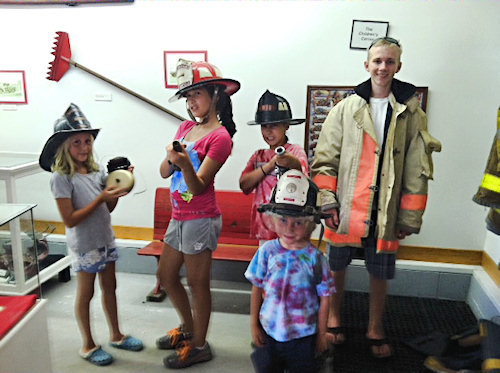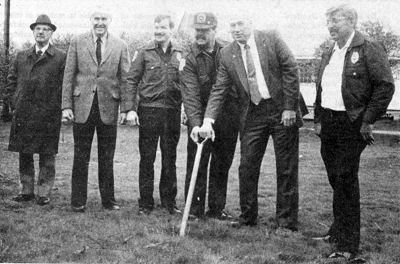




|
 Built by the Seacoast Firemanís Union, this building contains a 19th century fire pumper, a collection of antique fire alarms, a Whiting Light (precursor to todayís emergency flashing lights), photographs, and other fire fighting equipment.
Built by the Seacoast Firemanís Union, this building contains a 19th century fire pumper, a collection of antique fire alarms, a Whiting Light (precursor to todayís emergency flashing lights), photographs, and other fire fighting equipment.
Click here for a view of some of the exhibits that can be seen in the Fire Museum. Click here for historical photos of firemen and fire equipment.
|

Below are several articles detailing the construction and renovation of this building (From the Nov, 2004 issue of the HHS Newsletter) Eagle Scout projects at Tuck MuseumRecently two Eagle Scout projects were completed at the museum. Eagle Scout candidate Chris Larivee from Boy Scout Troop 177, with the help of community volunteers, has completely renovated the Fire Museum. The walls and floor were repainted, the cases repaired and repainted, and all the exhibits were cleaned and reinstalled with new information labels. A new feature is a Childrenís corner where visitors may try on coats and hats and ring the fire bell.
Work on the interior of the Fire Museum inspired Jonathan Coulp-Yu also of Troop 177 to work on the exterior of the building. With Jonathanís group of volunteers, the exterior of the Fire Museum was repainted, a stunning brick sidewalk was installed that connects three of our buildings, and low maintenance landscaping was added, tying the buildings together.
Museum Construction StartedBy Ed Ballam

Left to right, Roland Paige, Ansell Palmer, Robert Fabish, Mark Ouellette, John Walker, Anthony Kuncho. HAMPTON - The 1853 Fire Department hand tub and other firefighting artifacts will soon have a permanent home where the public can view them. The Fire Department held a ground-breaking ceremony Monday, May 6, at Tuck Field, thus commencing the construction of a fire museum to complement the Tuck Museum. Sponsor of the construction of the building is the Firefighters Union, Local 2664. The union will pay for all the construction costs of the 24-foot by 30-foot building and, upon completion, will turn the building over to the town. At that time, the building will become the responsiblity of the Tuck Museum and the town. At town meeting in March, residents voted to allow the department to build the museum at Tuck Field with the condition that the town would own the building and have the responsiblities for it. Chairman of the building committee Mark Ouellette said the money for the project came from the sale of ads in the annual business directory and yearbook the union puts out every year. He added that townpeople and business owners have already done their share towards construction of the museum by purchasing ads in the book and through donations. He also thanked those who supported the union through their donations. "They have already given us enough," Ouellette said of the townspeople. Firefighter Robert Fabish, resentative of the union, said the department has nozzles, old pieces of equipment and trophies to fill the building. Ouellette said that Robert "Vic" Lessard, a local contractor, has donated all of the equipment and the labor to complete the groundwork on the project. The building will be constructed on a cement slab in the rear of the Tuck Museum building, near the shed. The firefighters, who are donating the labor for the construction of the building, are hoping to have the building completed by the end of June. Once done, the building will be open for the inspection of the public during normal Tuck Museum hours. Fabish commented that the building will be used to show school children how the fire-fighters did their work in days gone by. He added that it will be particularly useful during fire prevention week in October when the department will conduct tours. Ouellette said that he would like to see the building become a museum for the entire Seacoast community, with other departments donating items to the museum. The wood-framed building will have an asphalt-shingled roof and pine clapboards on the exterior. As time passes and the union raises more money, they will start finishing the inside of the building. |